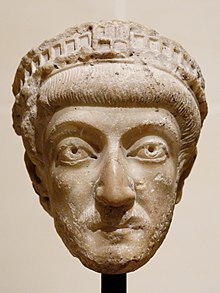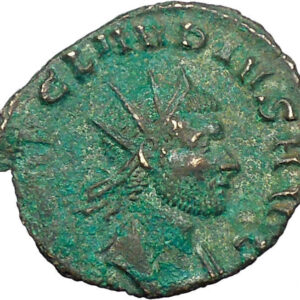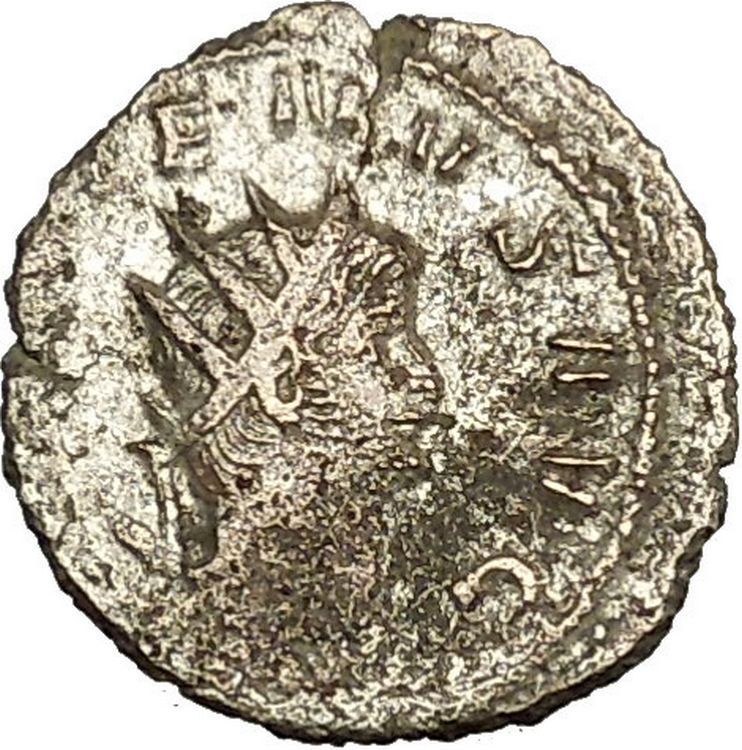|
Theodosius II – Roman Emperor: 408-450 A.D.
Bronze AE4 11mm (1.15 grams) Cyzicus mint, struck circa 425-435 A.D.
Reference: RIC X 437; LRBC 2602
D N THEODOSIVS P F AVG, Diademed, draped and cuirassed bust right.
CONCORDIA AVG / SMKB – Victory advancing facing forward, holding wreath in each hand.
You are bidding on the exact item pictured, provided with a Certificate of Authenticity and Lifetime Guarantee of Authenticity.
 In ancient Roman religion, Victoria or Victory was the personified goddess of victory. She is the Roman equivalent of the Greek goddess Nike, and was associated with Bellona. She was adapted from the Sabine agricultural goddess Vacuna and had a temple on the Palatine Hill. The goddess Vica Pota was also sometimes identified with Victoria. In ancient Roman religion, Victoria or Victory was the personified goddess of victory. She is the Roman equivalent of the Greek goddess Nike, and was associated with Bellona. She was adapted from the Sabine agricultural goddess Vacuna and had a temple on the Palatine Hill. The goddess Vica Pota was also sometimes identified with Victoria.
Unlike the Greek Nike, the goddess Victoria (Latin for “victory”) was a major part of Roman society. Multiple temples were erected in her honor. When her statue was removed in 382 CE by Emperor Gratianus there was much anger in Rome. She was normally worshiped by triumphant generals returning from war.
Also unlike the Greek Nike, who was known for success in athletic games such as chariot races, Victoria was a symbol of victory over death and determined who would be successful during war.
Victoria appears widely on Roman coins, jewelry, architecture, and other arts. She is often seen with or in a chariot, as in the late 18th-century sculpture representing Victory in a quadriga on the Brandenburg Gate in Berlin, Germany; “Il Vittoriano” in Rome has two.
Winged figures, very often in pairs, representing victory and referred to as “victories”, were common in Roman official iconography, typically hovering high in a composition, and often filling spaces in spandrels or other gaps in architecture. These represent the spirit of victory rather than the goddess herself. They continued to appear after Christianization of the Empire, and slowly mutated into Christian angels.
Theodosius II – Roman Emperor: 408-450 A.D.
402-408 A.D. – Junior Augustus (with Arcadius) | 408-450 A.D. – Sole reign
Ruling in the West: Honorius 393-423 A.D. | Constantine III 407-411 A.D. | Constans II 409-411 A.D. | Maximus 409-411 A.D. | Priscus Attalus 409-410A.D. and 415-416 A.D. | Jovinus 411-413 A.D. | Sebastianus 412-413 A.D. | Constantius III 421 A.D. | Johannes 423-425 A.D. and Valentinian III 425-455 A.D. |
| Son of Arcadius and Aelia Eudoxia | Brother of Aelia Pulcheria | Husband of Aelia Eudocia | Father of Licinia Eudoxia | Brother-in-law of Marcian | Father-in-law of Valentianian III and Petronius Maximus | Nephew of Honorius | Half-cousin of Valentinian III and Honoria | Grandson of Theodosius I and Aelia Flacilla |
 Theodosius II (Latin: Flavius Theodosius Iunior Augustus; 10 April 401 – 28 July 450), commonly surnamed Theodosius the Younger, or Theodosius the Calligrapher, was Eastern Roman Emperor from 408 to 450. He is mostly known for promulgating the Theodosian law code, and for the construction of the Theodosian Walls of Constantinople. He also presided over the outbreak of two great christological controversies, Nestorianism and Eutychianism. Theodosius II (Latin: Flavius Theodosius Iunior Augustus; 10 April 401 – 28 July 450), commonly surnamed Theodosius the Younger, or Theodosius the Calligrapher, was Eastern Roman Emperor from 408 to 450. He is mostly known for promulgating the Theodosian law code, and for the construction of the Theodosian Walls of Constantinople. He also presided over the outbreak of two great christological controversies, Nestorianism and Eutychianism.
Life
Theodosius was born in 401 as the only son of Emperor Arcadius and his Frankish-born wife Aelia Eudoxia. Already in January AD 402 he was proclaimed co-Augustus by his father, thus becoming the youngest person ever to bear this title in Roman history. In 408, his father died and the seven-year-old boy became Emperor of the Eastern half of the Roman Empire.
Government was at first by the Praetorian Prefect Anthemius, under whose supervision the Theodosian land walls of Constantinople were constructed.
In 414, Theodosius’ older sister Pulcheria was proclaimed Augusta and assumed the regency. By 416 Theodosius was declared Augustus in his own right and the regency ended, but his sister remained a strong influence on him. In June 421, Theodosius married Aelia Eudocia, a woman of Greek origin. The two had a daughter named Licinia Eudoxia. A separation ultimately occurred between the imperial couple, with Eudocia’s establishment in Jerusalem where she favoured monastic Monophysitism and Pulcheria reassuming an influential role with the support of the eunuch Chrysapius.
Theodosius’ increasing interest in Christianity, fuelled by the influence of Pulcheria, led him to go to war against the Sassanids (421-422), who were persecuting Christians; the war ended in a stalemate, when the Romans were forced to accept peace as the Huns menaced Constantinople.
In 423, the Western Emperor Honorius, Theodosius’ uncle, died and the primicerius notariorum Joannes was proclaimed Emperor. Honorius’ sister Galla Placidia and her young son Valentinian fled to Constantinople to seek Eastern assistance and after some deliberation in 424 Theodosius opened the war against Joannes. On 23 October 425, Valentinian III was installed as Emperor of the West with the assistance of the magister officiorum Helion, with his mother acting as regent. To strengthen the ties between the two parts of the Empire, Theodosius’ daughter Licinia Eudoxia was betrothed to Valentinian.
University and Law Code
In 425, Theodosius founded the University of Constantinople with 31 chairs (15 in Latin and 16 in Greek). Among subjects were law, philosophy, medicine, arithmetic, geometry, astronomy, music and rhetoric.
In 429, Theodosius appointed a commission to collect all of the laws since the reign of Constantine I, and create a fully formalized system of law. This plan was left unfinished, but the work of a second commission that met in Constantinople, assigned to collect all of the general legislations and bring them up to date was completed, and their collection published as the Codex Theodosianus in 438. The law code of Theodosius II, summarizing edicts promulgated since Constantine, formed a basis for the law code of Emperor Justinian I, the Corpus Juris Civilis, in the following century.
Wars with the Huns, Vandals, and Persians
The war with Persia proved indecisive, and a peace was arranged in 422 without changes to the status quo. The later wars of Theodosius were generally less successful.
The Eastern Empire was plagued by raids by the Huns. Early in Theodosius II’s reign Romans used internal Hun discord to overcome Uldin’s invasion of the Balkans. The Romans strengthened their fortifications and in 424 agreed to pay 350 pounds of gold to encourage the Huns to remain at peace with the Romans. In 433 with the rise of Attila and Bleda to unify the Huns, the payment was doubled to 700 pounds.
When Roman Africa fell to the Vandals in 439, both Eastern and Western Emperors sent forces to Sicily, intending to launch an attack on the Vandals at Carthage, but this project failed. Seeing the Imperial borders without significant forces, the Huns and Sassanid Persia both attacked and the expeditionary force had to be recalled. During 443 two Roman armies were defeated and destroyed by the Huns. Anatolius negotiated a peace agreement; the Huns withdrew in exchange for humiliating concessions, including an annual tribute of 2,100 Roman pounds (ca. 687 kg) of gold. In 447 the Huns went through the Balkans, destroying among others the city of Serdica (Sofia) and reaching Athyra (Büyükçekmece) on the outskirts of Constantinople.
Theological disputes

Theodosius welcomes the relics of John Chrysostom. Miniature from the early 11th century.
During a visit to to Syria Nestorius, who was a renowned preacher. He appointed Nestorius Archbishop of Constantinople in 428. Nestorius quickly became involved in the disputes of two theological factions, which differed in their Christology. Nestorius tried to find a middle ground between those who, emphasizing the fact that in Christ God had been born as a man, insisted on calling the Virgin Mary Theotokos (“birth-giver of God”), and those who rejected that title because God, as an eternal being, could not have been born. Nestorius suggested the title Christotokos (“birth-giver of Christ”) as a compromise, but it did not find acceptance with either faction. He was accused of separating Christ’s divine and human natures, resulting in “two Christs”, a heresy later called Nestorianism. Though initially supported by the emperor, Nestorius found a forceful opponent in Archbishop Cyril of Alexandria. At the request of Nestorius, the emperor called a council, which convened in Ephesus in 431. This council affirmed the title Theotokos and condemned Nestorius, who returned to his monastery in Syria and was eventually exiled to a remote monastery in Egypt.
Almost twenty years later, the theological dispute broke out again, this time caused by the Constantinopolitan abbot Eutyches, whose Christology was understood by some to mingle Christ’s divine and human nature into one. Eutyches was condemned by Archbishop Flavian of Constantinople but found a powerful friend in Cyril’s successor Dioscurus of Alexandria. Another council was convoked in Ephesus in 449, later deemed a “robber synod” by Pope Leo I because of its tumultuous circumstances. This council restored Eutyches and deposed Flavian, who was mistreated and died shortly afterwards. Leo of Rome and many other bishops protested against the outcome, but the emperor supported it. Only after his death in 450 would the decisions be reversed at the Council of Chalcedon.
Death
Theodosius died in 450 as the result of a riding accident. In the ensuing power struggle, his sister Pulcheria, who had recently returned to court, won out against the eunuch Chrysaphius. She married the general Marcian, thereby making him Emperor.
|




 In ancient Roman religion, Victoria or Victory was the personified goddess of victory. She is the Roman equivalent of the Greek goddess Nike, and was associated with Bellona. She was adapted from the Sabine agricultural goddess Vacuna and had a temple on the Palatine Hill. The goddess Vica Pota was also sometimes identified with Victoria.
In ancient Roman religion, Victoria or Victory was the personified goddess of victory. She is the Roman equivalent of the Greek goddess Nike, and was associated with Bellona. She was adapted from the Sabine agricultural goddess Vacuna and had a temple on the Palatine Hill. The goddess Vica Pota was also sometimes identified with Victoria. Theodosius II (Latin: Flavius Theodosius Iunior Augustus; 10 April 401 – 28 July 450), commonly surnamed Theodosius the Younger, or Theodosius the Calligrapher, was Eastern Roman Emperor from 408 to 450. He is mostly known for promulgating the Theodosian law code, and for the construction of the Theodosian Walls of Constantinople. He also presided over the outbreak of two great christological controversies, Nestorianism and Eutychianism.
Theodosius II (Latin: Flavius Theodosius Iunior Augustus; 10 April 401 – 28 July 450), commonly surnamed Theodosius the Younger, or Theodosius the Calligrapher, was Eastern Roman Emperor from 408 to 450. He is mostly known for promulgating the Theodosian law code, and for the construction of the Theodosian Walls of Constantinople. He also presided over the outbreak of two great christological controversies, Nestorianism and Eutychianism.





